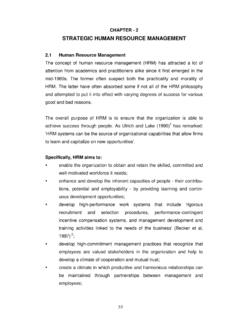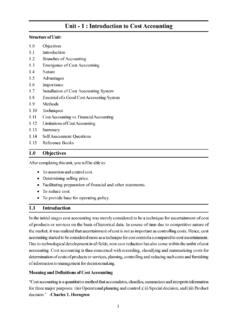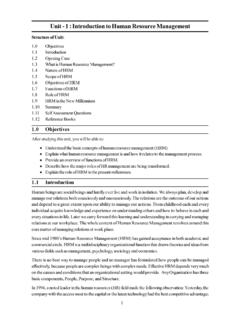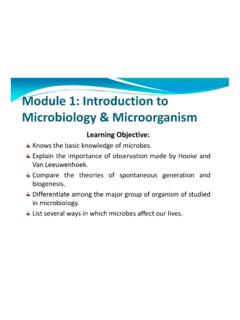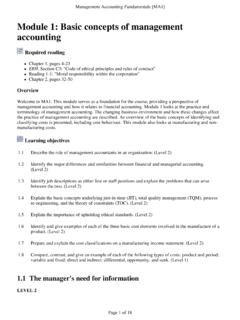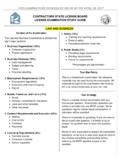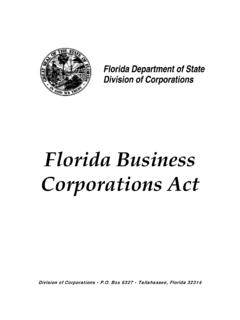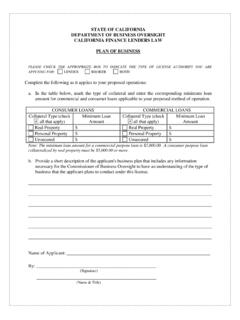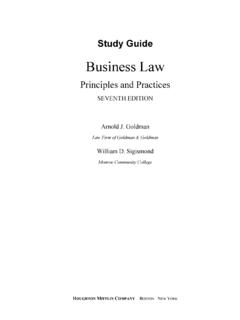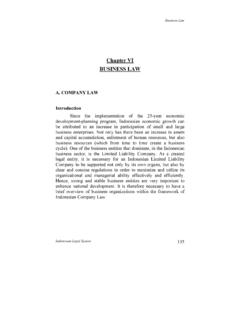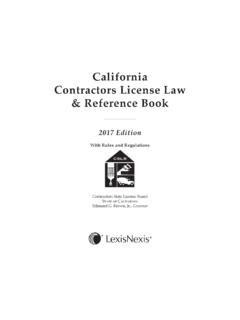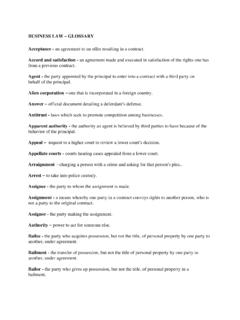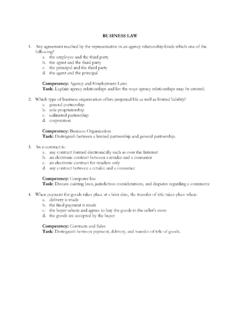Transcription of Business Law Notes - DPHU
1 2012 Certified Management Accountants of Ontario. All rights reserved. Business Law Notes Business Law Notes Page| i 2012 Certified Management Accountants of Ontario. All rights reserved. PART 1: LEGAL FUNDAMENTALS ..1 SECTION 1-1: INTRODUCTION TO LAW .. 1 Definition and Purpose of Law .. 1 Business Law versus Business Ethics .. 2 SECTION 1-2: SOURCES OF CANADIAN LAW AND THE LEGAL SYSTEM .. 2 Categories of Law .. 2 Systems of Law: Civil Law and Common Law .. 3 Sources of Law: The Constitution, Legislation, and the Courts .. 4 SECTION 1-3: USING THE COURTS - AN OVERVIEW OF CIVIL PROCEDURE .. 9 The Court System .. 9 The Litigation Process .. 11 Alternative Dispute Resolution .. 15 Administrative Tribunals .. 16 STUDY QUESTIONS FOR PART 1: LEGAL FUNDAMENTALS .. 17 ANSWERS TO STUDY QUESTIONS FOR PART 1: LEGAL FUNDAMENTALS.
2 19 PART 2: THE LAW OF TORTS .. 20 SECTION 2-1: INTRODUCTION TO TORT LAW .. 20 What is a Tort? .. 20 Development of Tort Law .. 22 Main Types of 23 SECTION 2-2: GENERAL PRINCIPLES OF TORT LAW .. 23 Burden of Proof .. 24 Liability .. 24 Defences .. 26 Limits to Damages in Torts .. 26 Remedies under Tort Law .. 26 SECTION 2-3: INTENTIONAL TORTS .. 28 SECTION 2-4: TORTS FROM Business OPERATIONS .. 30 SECTION 2-5: 32 Burden of Proof .. 32 Defences .. 36 Product Liability .. 37 Professional Liability .. 38 STUDY QUESTIONS FOR PART 2: THE LAW OF TORTS .. 40 ANSWERS FOR PART 2: THE LAW OF TORTS .. 43 PART 3: CONTRACT LAW .. 45 SECTION 3-1: ENTERING INTO A CONTRACT ELEMENTS OF A VALID CONTRACT .. 45 An Intention to Create Legal Relations .. 46 Offer .. 46 Acceptance of an Offer .. 49 Consideration .. 50 Certainty of Terms.
3 52 Capacity to Contract .. 53 Legality of Object .. 56 Business Law Notes Page| ii 2012 Certified Management Accountants of Ontario. All rights reserved. SECTION 3-2: PRIVITY OF CONTRACT AND ASSIGNMENT OF CONTRACTUAL RIGHTS57 Privity of Contract .. 58 Assignment of Rights .. 60 SECTION 3-3: THE REQUIREMENT OF WRITING .. 61 The Statute of Frauds .. 62 Consumer Protection Act .. 63 Sale of Goods Act .. 64 SECTION 3-4: INTERPRETING CONTRACTS .. 65 Interpretation of Express Terms .. 65 The Parol Evidence Rule .. 65 Implied Terms .. 66 SECTION 3-5: CONTRACTUAL DEFECTS .. 66 Mistake .. 67 Misrepresentation .. 70 Unfairness During Bargaining .. 72 SECTION 3-6: THE DISCHARGE OF CONTRACTS .. 73 Discharge by Performance .. 73 Discharge by Agreement .. 75 Discharge by Frustration .. 76 Discharge by Operation of Law.
4 77 Breach of 77 SECTION 3-7: BREACH OF CONTRACT .. 78 Essential and Non-Essential 78 Ways to Breach a Contract .. 78 Effects of a Breach .. 80 Exemption Clauses .. 81 Remedies for Breach of Contract .. 82 STUDY QUESTIONS FOR PART 3: CONTRACT LAW .. 85 ANSWERS FOR PART 3: CONTRACT LAW .. 89 PART 4: Business ENTITY LAW .. 91 SECTION 4-1: AGENCY RELATIONSHIPS .. 91 What is Agency? .. 91 Creation of an Agency Relationship .. 91 The Scope of an Agent s Authority .. 92 When is the Agent Liable? .. 93 Responsibilities of Agent to Principal .. 93 Responsibilities of Principal to Agent .. 94 Termination of Agency Relationship .. 94 SECTION 4-2: LEGAL FORMS OF Business .. 94 Sole Proprietorships .. 94 General Partnerships .. 95 Limited Partnerships .. 99 Limited Liability Partnerships .. 99 Corporation .. 100 SECTION 4-3: CORPORATE LAW.
5 100 Nature of a Corporation .. 100 Methods of Incorporation .. 101 Business Law Notes Page| iii 2012 Certified Management Accountants of Ontario. All rights reserved. Types of 102 Corporate Financing .. 103 Share Capital .. 103 Corporate Governance .. 104 The Business : External Relations .. 107 STUDY QUESTIONS FOR PART 4: Business ENTITY LAW .. 111 ANSWERS FOR PART 4: Business ENTITY LAW .. 114 PART 5: Business RELATIONSHIPS .. 115 SECTION 5-1: SALE OF GOODS .. 115 Application of the Sale of Goods Act .. 115 Passing of Property .. 116 Implied Contractual Obligations of the Seller .. 117 SECTION 5-2: CONSUMER PROTECTION .. 119 Principal Areas of Consumer Protection Legislation .. 119 Regulation of Business Conduct Towards Consumers .. 121 SECTION 5-3: BANKING .. 122 Banking Agreement .. 122 Negotiable Instruments.
6 123 Electronic Banking .. 125 SECTION 5-4: SECURED TRANSACTIONS AND CREDITORS 125 Secured Transactions .. 125 Creditors' Rights .. 127 Other Statutory Protection for Creditors .. 130 SECTION 5-5: EMPLOYMENT LAW .. 131 Pre-employment .. 131 During Employment .. 132 Termination and Post-Employment .. 134 SECTION 5-6: COMPETITION .. 135 Conspiracies .. 135 Monopolizing .. 135 Mergers .. 136 SECTION 5-7: ENVIRONMENTAL PROTECTION .. 136 Federal Legislation .. 137 Provincial Legislation .. 138 Corporate Liability .. 138 SECTION 5-8: INTERNATIONAL Business LAW .. 139 Laws to Control or Facilitate Trade .. 139 International Contracts of Sale .. 140 STUDY QUESTIONS FOR PART 5: Business RELATIONSHIPS .. 141 ANSWERS FOR PART 5: Business RELATIONSHIPS .. 144 PART 6: PROPERTY RIGHTS .. 146 SECTION 6-1: REAL PROPERTY .. 146 Estates in Land.
7 146 Interests Less than Estates .. 148 Leases .. 149 Termination of a Lease .. 150 Transfer of Interests in Land .. 151 Business Law Notes Page| iv 2012 Certified Management Accountants of Ontario. All rights reserved. Mortgages .. 151 Recording of Interests in Land .. 152 SECTION 6-2: PERSONAL PROPERTY .. 153 Acquiring Personal Property Rights .. 153 Bailment .. 153 Insurance .. 156 SECTION 6-3: INTELLECTUAL PROPERTY .. 157 The Nature of Intellectual Property .. 157 Copyrights .. 158 Trademarks .. 159 Patents .. 160 Industrial Designs .. 160 Remedies for Infringement of Intellectual Property Rights .. 160 Confidential Information .. 160 STUDY QUESTIONS FOR PART 6: PROPERTY RIGHTS .. 162 ANSWERS FOR PART 6: PROPERTY RIGHTS .. 164 Business Law Notes Page| 1 2012 Certified Management Accountants of Ontario.
8 All rights reserved. PART 1: LEGAL FUNDAMENTALS SECTION 1-1: INTRODUCTION TO LAW Law is essential to any society in that it provides the rules by which people and businesses interact. Law affects almost every function and area of Business . The authors of one Business law text go so far as to say that the difference between winning and losing in the Business world often depends upon the ability to make good choices from a legal perspective. 1 This is because almost every Business decision has legal repercussions, including deciding whether to incorporate a Business , obtaining financing, protecting proprietary knowledge used to develop products/services, entering into contracts to purchase raw materials, ensuring that products meet safety standards, disposing of plant wastes, promoting and pricing products/services, entering into contracts to sell products/services, and providing product warranties and after-sales service.
9 At all stages of Business , running afoul of the law can hurt a Business , while playing within the boundaries of the law can help the Business to succeed. For this reason, accountants, who play a key role in almost every aspect of operations, must have a solid working knowledge of the law. Definition and Purpose of Law The word law is generally associated with the word rules. McInnes, Kerr, and Van Duzer provide a simple definition of law as a rule that can be enforced by the courts. 2 Similarly, Yates defines law as the body of rules that can be enforced by the courts or by other government agencies. 3 DuPlessis and O Byrne define law as a set of rules and principles intended to guide conduct in society, primarily by protecting persons and their property; facilitating personal and commercial interactions; and providing mechanisms for dispute recognition.
10 4 Smyth, Soberman, Easson, and McGill describe what law does, which is to set standards of behaviour that are enforced by government, and also by individuals and groups with the help of government. 5 1 Mitchell McInnes, Ian R. Kerr, and J. Anthony VanDuzer, Managing the Law: The Legal Aspects of Doing Business , Third Edition, (Toronto: Pearson Canada, 2011), 2 McInnes et al., p. 7. 3 Richard A. Yates, Legal Fundamentals for Canadian Business , Second Edition, (Toronto: Pearson Canada, 2010), p. 1. 4 Dorothy DuPlessis, Steven Enman, Shannon O Byrne, and Sally Gunz, Canadian Business and the Law, Third Edition, (Toronto: Nelson, a Division of Thomson Canada Limited, 2008), p. 4. 5 Smyth, Soberman, Easson, and McGill, The Law and Business Administration in Canada, Twelfth Edition, (Toronto: Pearson Canada, 2010), p.


